We decided to step back and take in the larger picture of all of the emerging trends in the hosted VoIP market. This is one of the most dynamic markets in the technology world today: its growth is explosive, and there’s no end in sight. Every aspect of the way we do business has been touched by these emerging technologies, and more changes are just over the horizon. Last month, the research firm Frost & Sullivan released a comprehensive report on the state of the sector. Over the course of 173 pages, Elka Popova explored the services on offer today and took a look at who is already using Hosted VoIP, who will benefit from it in the near future, and the directions that providers can be expected to take as the market matures. The report was dense, and packed with valuable information. What we found was exciting, encouraging, and worth sharing with our readers. We mulled it over, digested it, and decided to put together this post so that you can take it all in at a glance. So what does the world of cloud communications look like today and where are we headed tomorrow?
Overcoming barriers: what’s in the way?
Before we examine the many ways this technology is thriving and how we expect it to impact businesses in the second half of this decade, it’s worth considering the obstacles that cloud communications are currently facing. While the future growth of VoIP is as close to a sure thing as you get in this world, there are still challenges slowing it down, and objections that some potential customers are raising. You may have said these things yourself.
- “The old stuff’s still here, and it works fine.”
The large installed base of traditional premises-based solutions mean that some companies (especially large companies with complex structures and legacy capital expenditures) don’t need or want to invest in new approaches or technologies - “I don’t trust it.”
The reputation of the cloud for security and reliability is getting stronger all the time, but some consumers still have concerns. - “Where do I even start?”
As in any new market, the competitive landscape is crowded and confusing. There are many providers and not a lot to go on when you’re trying to choose. We’re still looking for strong leaders to validate the value proposition of hosted IP communications.
As we’ll see in this post, while each of these constraints are legitimate, we can expect their impact to weaken over time. The first concern is rapidly dissipating due to the new demands of a rapidly evolving workplace. Traditional companies are shifting their organizational structures to encompass the needs of a highly mobile and remote workforce. Worries about security are giving way to the snowball effect: continued technological improvement along with growing (and contagious) consumer confidence about VoIP and cloud technologies will boost adoption at a steady rate. And confusion about which options make sense for any given business will begin to clear as the market matures and providers hone in on the services and features that matter most to their customers.
Crunching the numbers: where we are now?
Who is using the technology and why? Just how much is the market growing? In the last year alone, the hosted VoIP user base grew by 30.5 percent to reach 5.0 million users by year end in 2013. That means an additional 1.2 million new users have adopted cloud communication technology since year end 2012. This is good news for providers: last year’s market revenue added up to an astonishing $1.59 B. It’s also great news for the end users. A robust market like this creates a huge incentive for providers to up the ante on customer experience and service and drives innovation as companies jostle to differentiate themselves. We’ll take a more in-depth look at exactly what we can expect from that process later in the piece. For now, let’s examine the current market demographics and how they will play into emerging trends. The sea of prospective customers out there who can benefit from adopting VoIP and the cloud is deep and wide, but just who are they, and what do they need from the technology? Why should they get on board?
Small businesses are currently the biggest segment of hosted VoIP customers. In fact, the smaller the company, the more likely they are to adopt the solution.
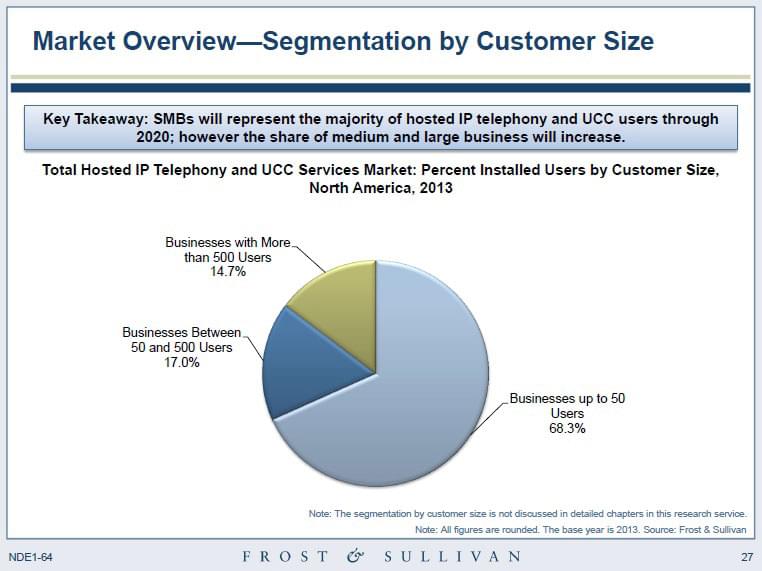
Underserved small and medium-sized businesses who could not afford traditional advanced collaboration and communication technologies are eager to take advantage of this new, affordable option. The low entry barrier, flexibility and scalability of hosted VoIP communication is appealing. While the impact of strained budgets is most apparent among smaller businesses, the fact is that everyone is feeling the pinch. Overall, businesses are facing serious challenges managing their IT and telecommunications needs.
In order to dig deeper into the reasons companies of all sizes are turning to VoIP, Frost and Sullivan ran a series of surveys among IT decision makers. In one, they asked about the biggest IT challenges that businesses are facing:
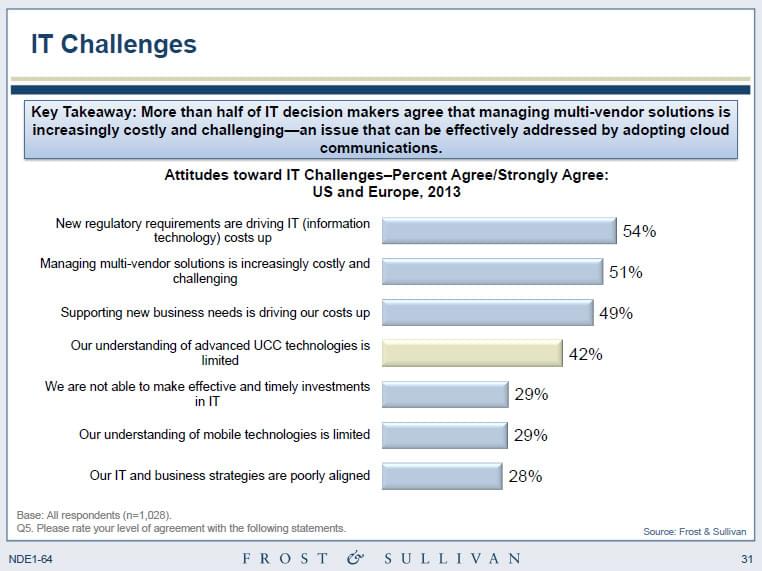
Many of these challenges can be solved with the adoption of affordable, flexible hosted cloud communications technologies, and we can expect cost to remain a powerful force in market growth. But while it may seem that everyone’s mind is on the bottom line, further surveys reveal other interesting motivations for businesses to adopt the technology.
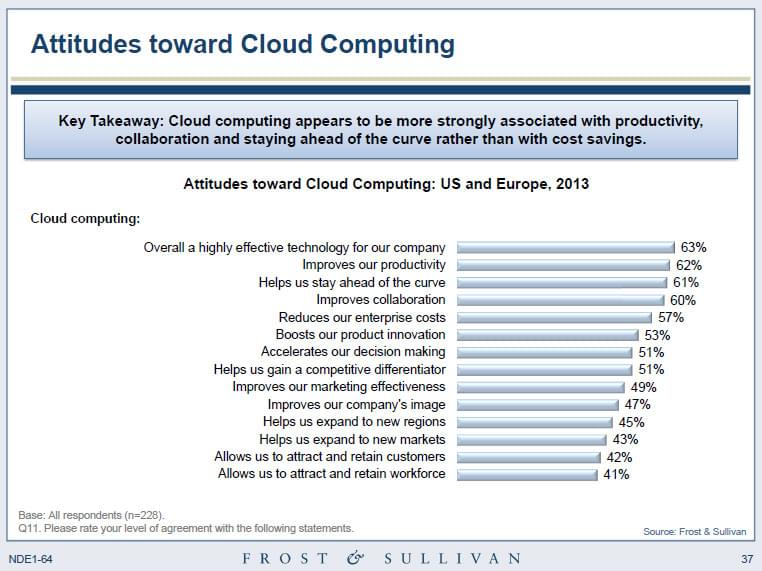
Companies perceive cloud computing to be an effective way to address many of the day-to-day concerns involved in running a business. Productivity and relevance are essential measures of how any organization is performing, and any tool that can support these goals is something that demands serious consideration. The fourth factor on that list, improving collaboration, is a major factor in the adoption of cloud communication technology by larger businesses:
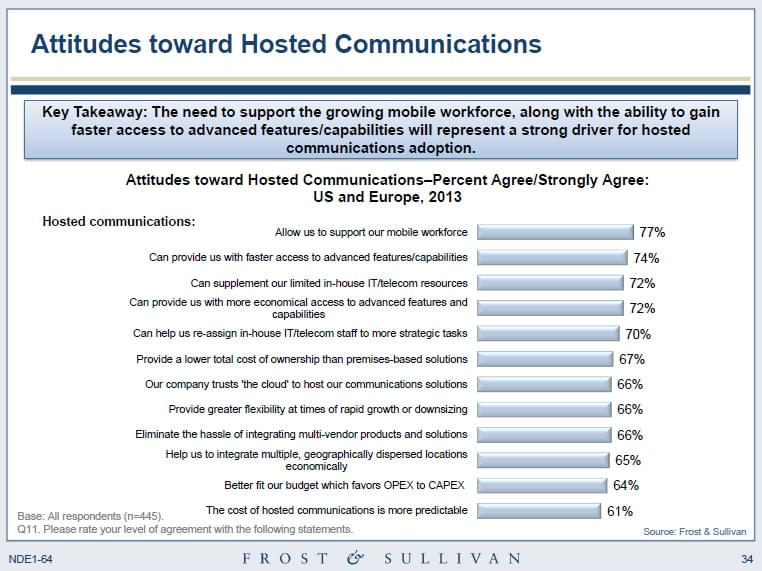
Larger, distributed organizations with many remote and mobile employees are beginning to find this technology invaluable in modern business. Globalization marches on, and the resulting distributed organizations are must find efficient ways to adapt their operations. Quick, responsive resources for managing and supporting geographically dispersed workers, locations, and markets are invaluable.The increasingly mobile and remote workforce is set to become an even bigger factor in how companies handle their communication and collaboration needs. To visualize exactly how quickly things are changing, here’s a picture of the rapidly changing workforce distribution:
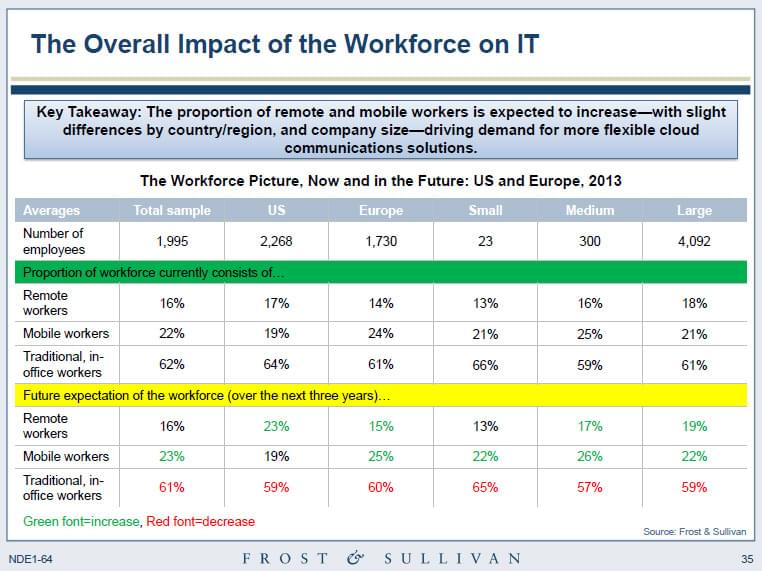
Clearly, this decentralization will continue to drive the search for more flexible solutions for border-less communication and collaboration. Hosted VoIP and cloud technologies are perfectly positioned to ride this wave to ever-greater heights. We expect this to be one of the most powerful drivers of growth in the market over the next five years.
The sky’s the limit: how much growth is on the way?
So just how big is this potential market? To understand the possible reach of cloud communications, we need to take a look at who is still out there to reach. Currently there are 138.2 M users of traditional business telephony, most of whom are future candidates for hosted cloud and VoIP adoption. The report has projected that between 2013 and 2020 market growth will hold steady with compound annual growth rates of 27.4 percent in terms of installed users:
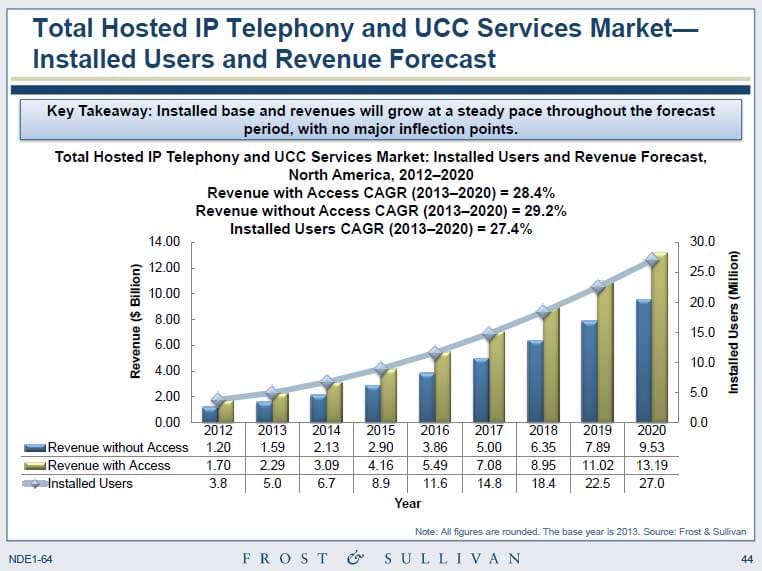
That inexorable upward climb is an exciting sign of what’s to come, but to really comprehend how far there is to go, we need to see the enormity of the untapped market. Even with that robust rate of growth over the next five years, cloud communication technologies will have barely scraped the surface of the possibilities. The full scale of future demand is startling. Those 27 million users in 2020 will still represent only 18.2 percent penetration:
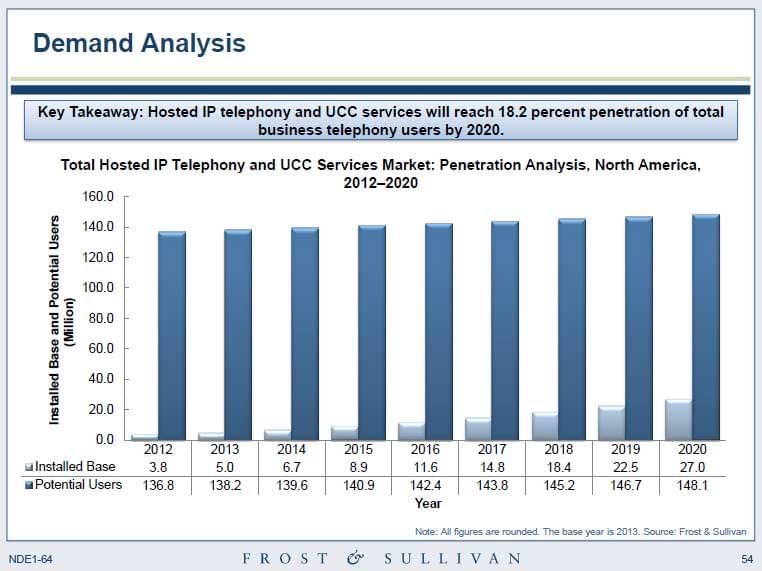
With so much room to grow, providers have an incredible mandate to expand their offerings and reach more businesses than ever before. We have every reason to believe that this will lead to an extremely positive environment for end users.
The future: who’s going to survive, and what will they offer us?
At the moment, there’s a bit of a wild-west attitude in the cloud communications arena. That sense of possibility and the resulting “gold rush” energy make it an exciting time for those within the industry, but it can lead to customers feeling perplexed as they try to sort out which provider is best able to meet the needs of their business. The dust is settling, however, and we can expect clearer markers of quality to appear. When we examine the current factors that customers use to determine which provider they select, it’s easy to see where vendors will be focusing their efforts:
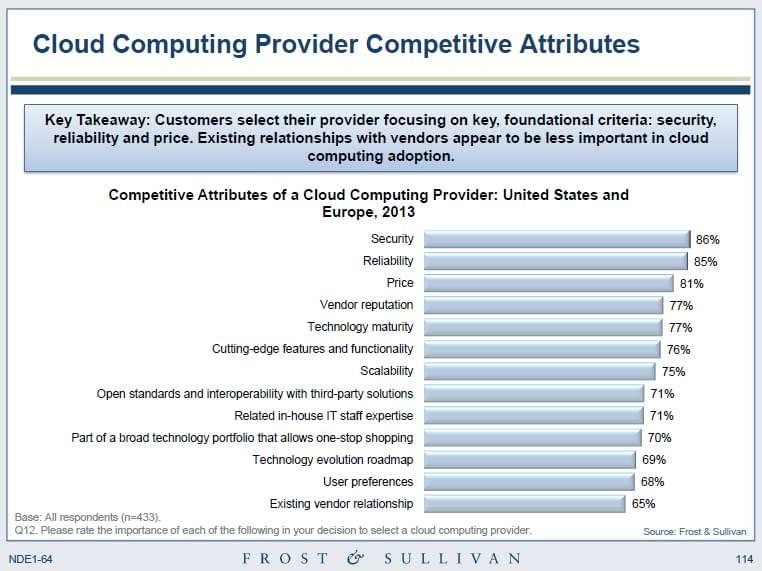
It’s a dog-eat-dog world out there for hosted VoIP providers. As the sector matures, we’ll start to see front-runners emerging who know how to deliver what customers want. These leaders will know how to succeed in a market that has overturned all the traditional monetization models of the telecommunications world, and that drive for differentiation will benefit customers in a number of ways.
The big telcos and vendors who have been scrambling to compete with this emerging technology will start using VoIP offerings as both a defensive and offensive strategy to keep up with changing customer needs. The expansive resources they will bring to the development and marketing of their cloud communication products will be a game changer. Among existing providers, we can also expect to see the market tighten up as mergers and acquisitions accelerate growth for some vendors. The resulting expanded channel capabilities and resources will enable them to improve the customer experience, service, and support they offer to their users. Overall, the providers who will survive and succeed long-term will be those who focus on the basics: streamlining operations and retaining customers with service quality and reliability and back-office systems efficiency.
When it comes to the product itself, several trends are becoming clear. The basic packages offered to users are expected to evolve more in terms of quality than content. As the market continues to adjust to new monetization strategies, advanced services will remain important up-sells: instant messaging, PC/Mac-based soft clients, enhanced mobility, video, web collaboration and contact center. However, bundling strategies will remain about the same, and due the the fierce pressure of competition, the average revenue per user will also stay steady, which is good news for the consumer.
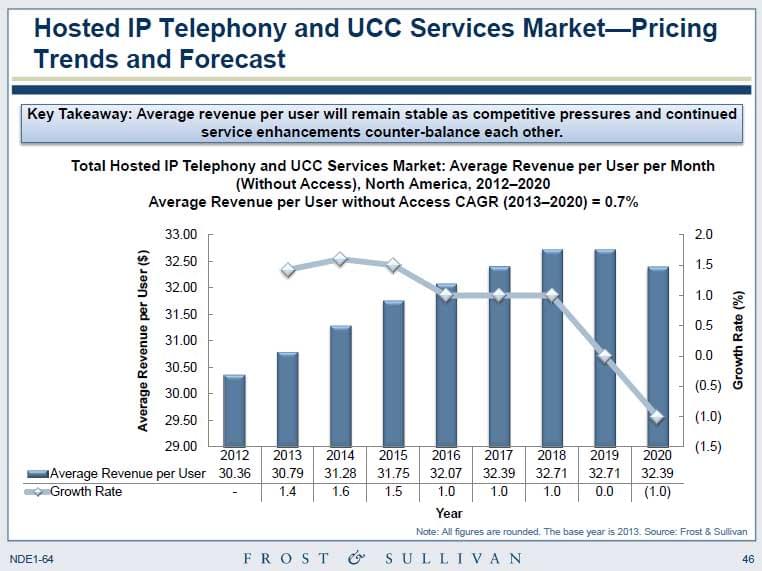
Because budgetary concerns are set to remain a major factor in adoption, the manner in which cloud services are delivered really matters: the need for flexible and cost-effective broadband access is paramount. This where hosted solutions really come to the fore. Providers who can offer this are already winning customers, and the trend is set to continue:
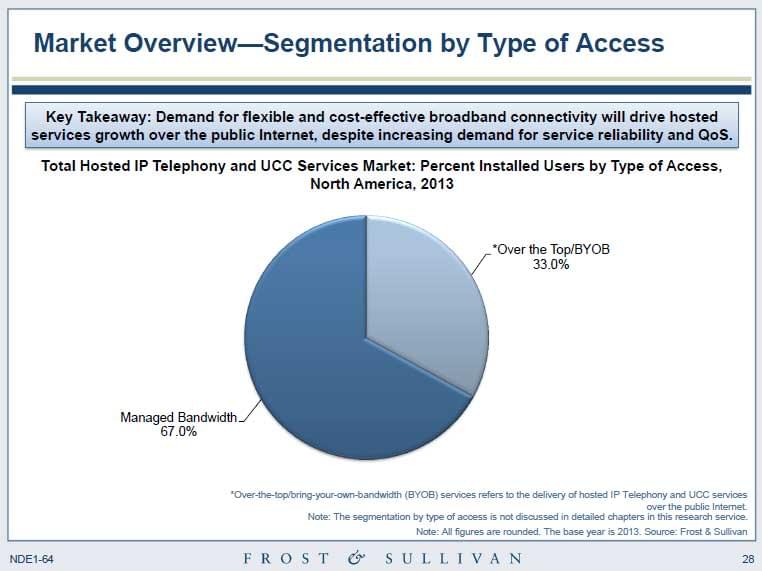
Additionally, multi-instance platforms will grow in popularity and market share: the security and customization benefits are great, and it’s much easier for users to reuse and integrate existing structures. On a similar note, the user interface will become increasingly important. The trend across all technologies is strongly in favor of more things in sync. The capabilities of the cloud are uniquely suited to this demand, and service providers will stress their ability to integrate with third-party communications and productivity applications.
In conclusion:
Clearly, things are just getting started. The potential for growth in hosted cloud communication technologies remains staggering, and the incentives for adoption are increasing in both urgency and strength. Companies are shifting their patterns of work, giving rise to the virtual organization as the workforce grows ever more mobile. Businesses of all sizes are looking for cost-effective and ubiquitous connectivity across a galaxy of devices. Both consumers and businesses are expecting ever-greater customization and personalization of the technologies they use every day. Hosted VoIP and cloud technologies are roaring in to address these needs, and the fierce competition from providers to grab the top place is poised to offer consumers continually improving products and services, while keeping prices at an attractively affordable level. The future, for all of us, is very bright.








